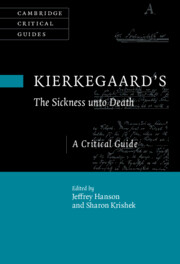Book contents
- Kierkegaard’s The Sickness unto Death
- Cambridge Critical Guides
- Kierkegaard’s The Sickness unto Death
- Copyright page
- Contents
- Contributors
- Acknowledgments
- Abbreviations
- Introduction
- Chapter 1 Kierkegaard’s Place of Rest
- Chapter 2 Publishing The Sickness unto Death
- Chapter 3 Kierkegaard on the Self and the Modern Debate on Selfhood
- Chapter 4 From Here to Eternity
- Chapter 5 Kierkegaard’s Metaphysics of the Self
- Chapter 6 The Experience of Possibility (and of Its Absence)
- Chapter 7 Sin, Despair, and the Self
- Chapter 8 Sin and Virtues
- Chapter 9 Despair as Sin
- Chapter 10 Fastening the End and Knotting the Thread
- Chapter 11 Despair the Disease and Faith the Therapeutic Cure
- Chapter 12 The Long Journey to Oneself
- Chapter 13 Accountability to God in The Sickness unto Death
- Bibliography
- Index
- Cambridge Critical Guides
Chapter 2 - Publishing The Sickness unto Death
A Lesson in Double-Mindedness
Published online by Cambridge University Press: 26 August 2022
- Kierkegaard’s The Sickness unto Death
- Cambridge Critical Guides
- Kierkegaard’s The Sickness unto Death
- Copyright page
- Contents
- Contributors
- Acknowledgments
- Abbreviations
- Introduction
- Chapter 1 Kierkegaard’s Place of Rest
- Chapter 2 Publishing The Sickness unto Death
- Chapter 3 Kierkegaard on the Self and the Modern Debate on Selfhood
- Chapter 4 From Here to Eternity
- Chapter 5 Kierkegaard’s Metaphysics of the Self
- Chapter 6 The Experience of Possibility (and of Its Absence)
- Chapter 7 Sin, Despair, and the Self
- Chapter 8 Sin and Virtues
- Chapter 9 Despair as Sin
- Chapter 10 Fastening the End and Knotting the Thread
- Chapter 11 Despair the Disease and Faith the Therapeutic Cure
- Chapter 12 The Long Journey to Oneself
- Chapter 13 Accountability to God in The Sickness unto Death
- Bibliography
- Index
- Cambridge Critical Guides
Summary
The chapter outlines the biographical context of 1848, when Denmark underwent a revolution and its Church was reconstituted. In 1848 Kierkegaard felt himself at a turning point in his own life: He was looking back at his difficult childhood and Christian upbringing and considering his professional future. The same year was also a turning point in his relationship to the Danish State Church and its head, Bishop Mynster. Having declared an end to his authorship, Kierkegaard was trying to decide how to express his developing views and how far he should go in his critique of the Church. From a literary point of view, The Sickness unto Death signaled the increasing prominence of the genre of the religious discourse, while from a theological point of view it shows Kierkegaard drawing closer to the ideal of imitating Christ. At the same time, The Sickness unto Death presents his mature philosophical position, in continuity with his earlier works, consolidated in his analysis of the human being’s spiritual condition and the ideal of faith as “resting transparently in God.” The personal, philosophical, and professional questions underlying The Sickness unto Death caused a long delay in its publication; these questions were eventually resolved by the invention of a new pseudonym, Anti-Climacus.
- Type
- Chapter
- Information
- Kierkegaard's The Sickness Unto DeathA Critical Guide, pp. 26 - 41Publisher: Cambridge University PressPrint publication year: 2022



